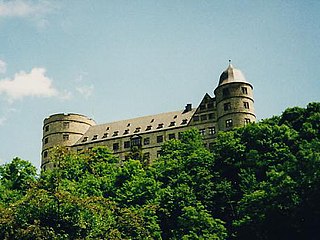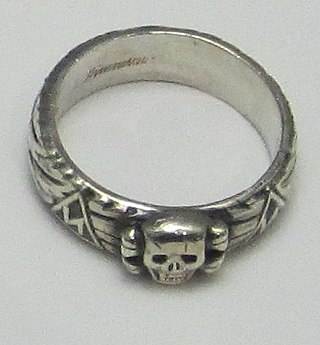
Wewelsburg is a Renaissance castle located in the village of Wewelsburg, which is a district of the town of Büren, Westphalia, in the Landkreis of Paderborn in the northeast of North Rhine-Westphalia, Germany. The castle has a triangular layout, with three round towers connected by massive walls. After 1934 it was used by the SS under Heinrich Himmler, and was to be expanded into a complex which would serve as the central SS cult-site.
Karl Maria Wiligut was an Austrian occultist and soldier. He served in the Austro-Hungarian Army during World War I and was a leading figure in the Irminism movement, eventually joining the SS after being recruited by Heinrich Himmler.

Guido Karl Anton List, better known as Guido von List, was an Austrian occultist, journalist, playwright, and novelist. He expounded a modern Pagan new religious movement known as Wotanism, which he claimed was the revival of the religion of the ancient German race, and which included an inner set of Ariosophical teachings that he termed Armanism.

The association of Nazism with occultism occurs in a wide range of theories, speculation, and research into the origins of Nazism and into Nazism's possible relationship with various occult traditions.

The SS-Ehrenring, unofficially called Totenkopfring, was an award of Heinrich Himmler's Schutzstaffel (SS). It was not a state decoration, but rather a personal gift bestowed by Himmler. It became a highly sought-after award, one which could not be bought or sold. The SS Honour Sword and SS Honour Dagger were similar awards.

Armanen runes are 18 pseudo-runes, inspired by the historic Younger Futhark runes, invented by Austrian mysticist and Germanic revivalist Guido von List during a state of temporary blindness in 1902, and described in his Das Geheimnis der Runen, published as a periodical article in 1906, and as a standalone publication in 1908. The name seeks to associate the runes with the postulated Armanen, whom von List saw as ancient Aryan priest-kings. The Armanen runes continue in use today in esotericism and in Germanic neopaganism.

Armanism and Ariosophy are esoteric ideological systems that were largely developed by Guido von List and Jörg Lanz von Liebenfels, respectively, in Austria between 1890 and 1930. The term 'Ariosophy', which translates to wisdom of the Aryans, was invented by Lanz von Liebenfels in 1915, and during the 1920s, it became the name of his doctrine. For research on the topic, such as Nicholas Goodrick-Clarke's book The Occult Roots of Nazism, the term 'Ariosophy' is generically used to describe the Aryan/esoteric theories which constituted a subset of the 'Völkische Bewegung'. This broader use of the word is retrospective and it was not generally current among the esotericists themselves. List actually called his doctrine 'Armanism', while Lanz used the terms 'Theozoology' and 'Ario-Christianity' before the First World War.

The Black Sun is a type of sun wheel symbol originating in Nazi Germany and later employed by neo-Nazis and other far-right individuals and groups. The symbol's design consists of twelve radial sig runes, similar to the symbols employed by the SS in their logo. It first appeared in Nazi Germany as a design element in a castle at Wewelsburg remodeled and expanded by the head of the SS, Heinrich Himmler, which he intended to be a center for the SS.
The Armanen-Orden was founded as a revival of the Ariosophical Guido von List Society by German occultist Adolf Schleipfer and his then-wife Sigrun von Schlichting.
Karl Spiesberger was a German mystic, occultist, Germanic revivalist and Runosophist. He is most well known for his revivalism and usage of the Sidereal Pendulum for divination and dowsing and for his anti-racialist stance and revivalist usage of the Armanen Futharkh runic system after the second world war, removing its negative connotations. During his involvement with the Fraternitas Saturni Spiesberger was also known as Frater Eratus. Under this name he published several articles in the Blätter für angewandte okkulte Lebenskunst.
Friedrich Bernhard Marby was a German rune occultist and Germanic revivalist. He is best known for his revivalism and use of the Armanen runes. Marby was imprisoned during the Third Reich, which may have been due to a denunciation by Karl Maria Wiligut. According to the Odinist magazine Vor Trú, Marby "was one of the most important figures in the realm of runic sciences" with an impact felt not only by contemporaries but "among today's researchers and practitioners."

Zodiac and Swastika: How Astrology Guided Hitler's Germany is a 1968 book by Wilhelm Theodor H. Wulff. It was released in 1973 in the United States by Coward, McCann & Geoghegan and in the United Kingdom by Arthur Barker Limited of London. The English edition has a foreword by the historian Walter Laqueur.

Wendehorn is a pseudo-runic symbol resembling the Tvimadur symbol. It is allegedly a bindrune of the Man and Yr runes, symbolizing 'life' and 'death' respectively. The term is due to Guido von List's Das Geheimnis der Runen, where it does not figure as a full member of the Armanen runes, but is mentioned in the context of the crescent moon being "the rune of Freya, who promotes childbirth." It was taken up by List's Armanist followers, such as Rudolf John Gorsleben, and Siegfried Adolf Kummer and is still in use in Irminenschaft and Armanenschaft-inspired esotericism today.

Hagal is the 7th pseudo-rune of Armanen Futharkh of Guido von List, derived from the Younger Futhark Hagal rune ᚼ.

Friedrich Wannieck was a prominent and wealthy Austrian/German industrialist most notable for his successful business ventures and his enthusiastic support for the völkisch author, pioneer of Germanic mysticism and runic revivalist, Guido von List. He is the father of Friedrich Oskar Wannieck.
Germany and Austria have spawned many movements and practices in Western esotericism, including Rosicrucianism, Theosophy, Anthroposophy and Ariosophy, among others.
Historians, political scientists and philosophers have studied Nazism with a specific focus on its religious and pseudo-religious aspects. It has been debated whether Nazism would constitute a political religion, and there has also been research on the millenarian, messianic, and occult or esoteric aspects of Nazism.
Runic alphabets have seen numerous uses since the 18th-century Viking revival, in Scandinavian Romantic nationalism (Gothicismus) and Germanic occultism in the 19th century, and in the context of the Fantasy genre and of Germanic Neopaganism in the 20th century.

Allerseelen is the musical project of the Austrian musician Gerhard Petak, also known as Kadmon and Gerhard Hallstatt. Briefly a group in 1987, it has been a solo project since 1989; Petak collaborates with groups for performances. His music is experimental, sometimes post-industrial and military pop and has often fallen into the neo-folk and pagan rock categories. He is known for his use of lyrics by Nazi authors, and has also written admiringly of Nazi cultural figures and collaborated with right-wing extremist musicians.











